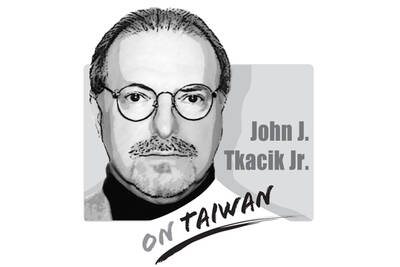Six years since democratically taking power, President Chen Shui-bian's (陳水扁) administration has failed to redress the injustice done to tens of thousands of small landowners whose land was seized as a result of the Chinese Nationalist Party's (KMT) Land Reform Act (實施耕者有其田條例) implemented in 1953.
Transitional justice is an academic term that enjoys a great deal of currency in the Chen administration. It refers to the attempts of newly democratic countries to right wrongs committed by earlier authoritarian governments.
While the Chen administration has managed to render some transitional justice to the victims of the 228 Incident and to at least publicize the issue of the KMT's stolen assets, nothing has been done for the victims of the KMT's land reform.
To implement its land reform program, the KMT government classified Taiwanese farmers as landlords or tenant farmers. The term "landlord" became a synonym for a class of exploiters who were to be eliminated, while "tenant farmer" referred to the vast numbers of the poor who were being exploited.
Research on the KMT's land policy in China, however, shows that the KMT classified and defined farming households very differently before it came to Taiwan.
In 1928, the Central Land Commission issued a survey on land holdings in rural China. The survey divided farming households into five classes: poor peasants, middle class peasants, rich peasants, small and medium sized landlords and large scale landlords.
It defined a small landlord as one who owned the equivalent of 3.07 hectares of land. By this standard, only 6.77 percent of Taiwan's peasant households in the early 1950s qualified as small landlords.
In 1933, the Cabinet issued another study defining Chinese landlords as those who owned at least 5.12 hectares. By this standard, just 2.88 percent of Taiwan's landowners would have qualified as landlords.
And in 1941, the Bureau of Statistics defined a landlord as someone owning 18.41 hectares. By this standard, just 0.9 percent of Taiwan's farming households would have qualified. The Bureau of Statistics identified 1,545 such landlords in its study covering 89 counties in 11 Chinese provinces.
The results of these studies showed that the vast majority of Taiwanese farming households owned less farmland than landlords in China did.
But when the KMT carried out land reform in Taiwan, it reclassified farming households and redefined the meaning of landlord. In effect, practically anyone who rented out land was classified as a landlord, no matter how little land he actually owned.
The result was that a total of 106,049 households were classified as landlords. The vast majority were in fact land owners who rented out land that they owned. Most owned no more than a few thousand square meters. Nevertheless, if these owners had rented their land out, it was appropriated and they lost their titles.
Deprived of the title to their land, many of these former landowners fell into poverty. A contemporary team of observers estimated that more than 2 million people were affected.
Those in power controlled and manipulated land reform in Taiwan by controlling and manipulating the classification and definition of agrarian households to suit their changing needs. The Taiwanese landowners who held titles to their land were of course given no say in the matter.
More than 50 years later, those small landowners -- unfairly labeled landlords -- are still waiting for justice.
Hsu Shih-jung is a professor in the Department of Land Economics at National Chengchi University.
Translated by Michael Fahey

“Si ambulat loquitur tetrissitatque sicut anas, anas est” is, in customary international law, the three-part test of anatine ambulation, articulation and tetrissitation. And it is essential to Taiwan’s existence. Apocryphally, it can be traced as far back as Suetonius (蘇埃托尼烏斯) in late first-century Rome. Alas, Suetonius was only talking about ducks (anas). But this self-evident principle was codified as a four-part test at the Montevideo Convention in 1934, to which the United States is a party. Article One: “The state as a person of international law should possess the following qualifications: a) a permanent population; b) a defined territory; c) government;
The central bank and the US Department of the Treasury on Friday issued a joint statement that both sides agreed to avoid currency manipulation and the use of exchange rates to gain a competitive advantage, and would only intervene in foreign-exchange markets to combat excess volatility and disorderly movements. The central bank also agreed to disclose its foreign-exchange intervention amounts quarterly rather than every six months, starting from next month. It emphasized that the joint statement is unrelated to tariff negotiations between Taipei and Washington, and that the US never requested the appreciation of the New Taiwan dollar during the
Since leaving office last year, former president Tsai Ing-wen (蔡英文) has been journeying across continents. Her ability to connect with international audiences and foster goodwill toward her country continues to enhance understanding of Taiwan. It is possible because she can now walk through doors in Europe that are closed to President William Lai (賴清德). Tsai last week gave a speech at the Berlin Freedom Conference, where, standing in front of civil society leaders, human rights advocates and political and business figures, she highlighted Taiwan’s indispensable global role and shared its experience as a model for democratic resilience against cognitive warfare and
The diplomatic spat between China and Japan over comments Japanese Prime Minister Sanae Takaichi made on Nov. 7 continues to worsen. Beijing is angry about Takaichi’s remarks that military force used against Taiwan by the Chinese People’s Liberation Army (PLA) could constitute a “survival-threatening situation” necessitating the involvement of the Japanese Self-Defense Forces. Rather than trying to reduce tensions, Beijing is looking to leverage the situation to its advantage in action and rhetoric. On Saturday last week, four armed China Coast Guard vessels sailed around the Japanese-controlled Diaoyutai Islands (釣魚台), known to Japan as the Senkakus. On Friday, in what